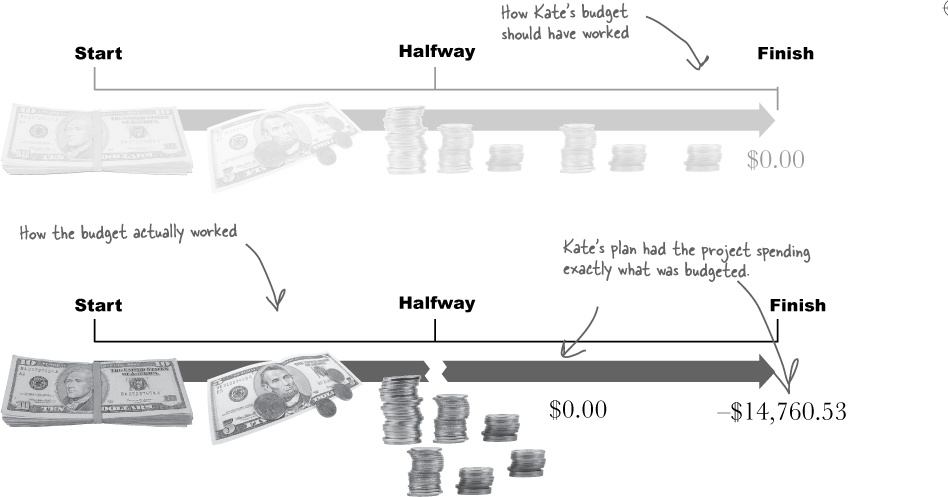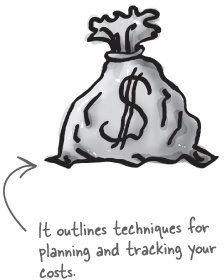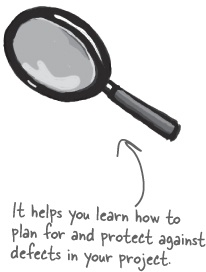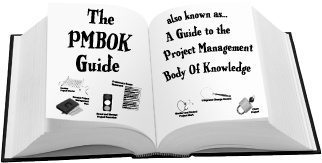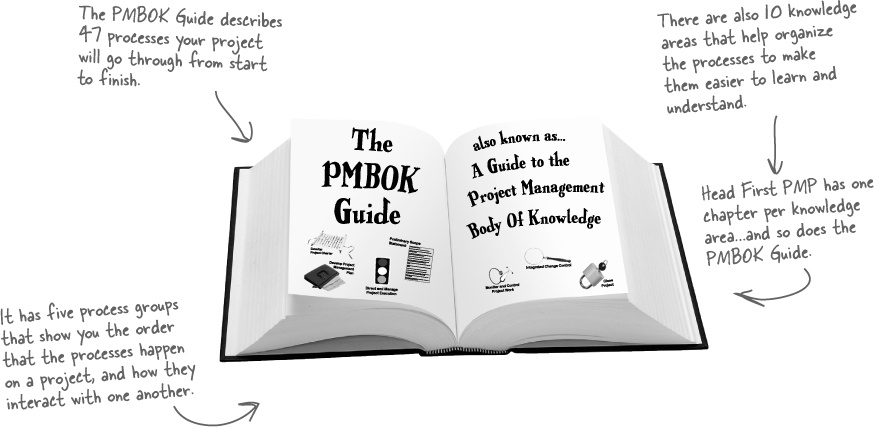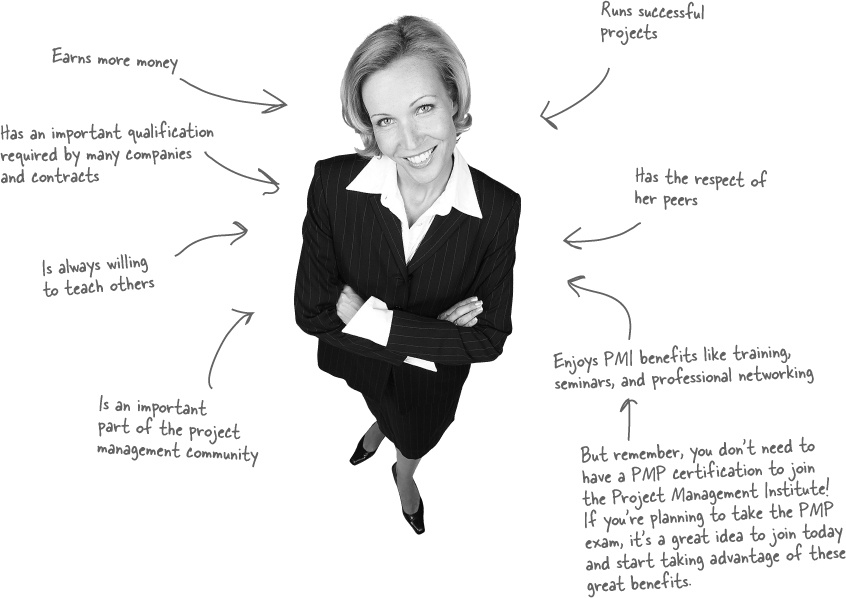Chapter 1. Introduction: Why get certified?
Tired of facing the same old problems? If you’ve worked on a lot of projects, you know that you face the same problems, over and over again. It’s time to learn some common solutions to those problems. There’s a whole lot that project managers have learned over the years, and passing the PMP exam is your ticket to putting that wisdom into practice. Get ready to change the way you manage your projects forever.
Do these problems seem familiar?
Kate’s boss promised a delivery date that she couldn’t possibly meet.
Then, when the project was halfway done, the customer demanded a big change.
Then, just as the project was about to be completed, someone noticed a couple typos, and 10,000 leaflets had to be reprinted.
Then, when it was time to fix those typos, Kate realized that the printer was booked for another project.
And even though she knew there was a pretty good chance that someone else might need the printer, she didn’t have time to come up with a backup plan.
Projects don’t have to be this way
It may seem like all projects have these types of problems, but there are proven solutions to them...and someone else has already done a lot of the work for you! Realizing that all projects have common problems with solutions, a team of experts put together the PMBOK Guide to pass those solutions on to you.
Your problems...already solved
Every project eventually runs into the same kinds of issues. But a project manager with good training can spot them early, and quickly figure out the best solutions. The PMBOK Guide will help you:
What you need to be a good project manager
The PMBOK Guide is full of practical tools that can help you manage your projects better. But all of that doesn’t mean much if you don’t have the three core characteristics of a successful project manager. You’ve got to pay attention to all three if you want to make your project a success. This is what you’ll need if you’re going to take on the role of project manager:
The PMBOK Guide is just a guide, but if you understand all the material in it, then you’ll ultimately be a better project manager.
Understand your company’s big picture
Your project is an important part of the work your company is doing, but you need to understand how it fits in to the higher-level strategy your company is executing, too. That’s where programs and portfolios come in.
Your project has value
Think about the projects you’ve worked on in your career. Each one of them did something beneficial for your company. You might’ve created a product and sold it to customers to make money directly. You might’ve made someone’s job easier by automating work that would’ve taken time and effort to do. No matter how you count the benefit you created when you completed your project, that benefit is the real reason that your company decided to do the work in the first place. That benefit has an impact on the overall business value of the company you work for. Sometimes it can be easy to spend so much time dealing with your project’s issues that you lose track of the goals you set out to achieve. It’s important to think about the value of your project with every decision you make.
Business value is the sum of all of the things your company is made of, from desks and chairs to people and the intellectual property they produce.
Portfolios, programs, and projects have a lot in common
We’ve talked about the differences between portfolio management, program management, and project management, but there are a lot of similarities between them too.
Professions with proven processes
Portfolio managers and program managers have a set of proven processes, tools, and techniques that have been used to manage many successful programs and portfolios. Like the PMP, the Project Management Institute offers certifications in Portfolio (PfMP) and Program Management (PgMP) too.
Business value
Portfolio managers prioritize work to meet a company’s strategic goals. Managing a program is all about keeping track of resources and other constraints affecting groups of projects so that all of those projects can achieve some shared benefit. Projects, on the other hand, are about managing the work to achieve some result. A portfolio’s strategic goals, a program’s shared benefit, and the result of that project add business value to your company.
Deal with constraints
Portfolio managers need to prioritize work in environments with limited resources, budgets, risk tolerance, and many other constraints that set up the environment for their portfolio’s success. Program managers need to manage groups of projects that are being produced by the same resource pool or from the same budget. Project managers often have predefined schedules, resource constraints, and scope requirements to manage. All three need to use the processes, tools, and techniques that have worked for other managers to balance all of the constraints in their business environments.
Portfolios, programs, and projects all use charters
All of the work you do to initiate, plan, execute, control, and close your project helps your program and portfolio managers understand how your project is doing and keep it on track. Following all of the processes in the PMBOK Guide will ensure that the programs and portfolios of which your project is a part always know how you’re doing and what you’ll accomplish. While there are many differences in the documents that are used in portfolio and program management, all three use a charter to define their objectives.
Charter
Portfolios, programs, and projects all use a charter to define their goals and initiate work. A charter lists any known constraints and goals and gives the manager authority to get the work started.
Relax
We’ll talk about the project charter in depth in Chapter 4.
While the charter is used in projects, programs, and portfolios, you really only need to focus on the project charter for the exam. We’ll spend a lot of time on the project charter later in the book.
What a project IS...
Note
Operations are ongoing. If you’re building cars on an assembly line, that’s an operation. If you’re designing and building a prototype of a specific car model, that’s a project.
Note
You might also see the word “process” instead of “operation.” A team might run a project to build software, but the company might have an ongoing process for keeping the servers that run the software from going down. In fact, the group that keeps those servers running is often called “IT Operations.” Get it?
A day in the life of a project manager
You probably already know a lot of what a project manager does: gets a project from concept to completed product. Usually a project manager works with a team of people to get the work done. And PMs don’t usually know a lot about the project when they start. When you think about it, you can categorize pretty much everything a project manager does every day into three categories.
Gather product requirements
Being a project manager almost always means figuring out what you’re going to build. It’s one of the first things you do when you start to plan the project! But as you go, you are always learning more and more. Sometimes that can mean changes to your product, while other times it’s just more detail on what you already knew.
Manage stakeholder expectations
There are a lot of people involved in making most projects happen: the team that actually does the work, the people who pay for it, everybody who will use the product when you’re done, and everybody who might be impacted by the project along the way. Those people are called your stakeholders. And a big part of the PM’s job is communicating with everybody and making sure their needs are met.
Note
One of the most important stakeholders is the sponsor. That’s the person who provides financial and political support for the project.
Deal with project constraints
Sometimes there will be constraints on the project that you’ll need to deal with. You might start a project and be told that it can’t cost more than $200,000. Or it absolutely MUST be done by the trade show in May. Or you can do it only if you can get one specific programmer to do the work. Or there’s a good chance that a competitor will beat you to it if you don’t plan it well. It’s constraints like these that make the job more challenging, but it’s all in a day’s work for a project manager.
Even though you’re constantly gathering requirements, managing stakeholders, and working within constraints, different situations can call for different tools for dealing with all of those challenges. When you think about it, all of the tools and techniques that are discussed in the PMBOK Guide are there to help you do those three things at different points in your project’s lifecycle. That’s why the PMBOK Guide divides up the work you do on a project into the five process groups. The groups help you organize all of the work you do as your project progresses and keep your role in the project straight.
Note
You’ll learn all about the process groups in Chapter 3!
How project managers run great projects
There are plenty of ways that you can run a project; people have been running projects for about as long as civilization has been around. But some project managers run their projects really effectively, while others consistently come in late, over budget, and with poor quality. So what makes the difference between a great project and one that faces challenges?
That’s exactly the question that the folks at the Project Management Institute asked when they started putting together their Guide to the Project Management Body of Knowledge. They surveyed thousands of project managers and analyzed tens of thousands of successful and unsuccessful projects to come up with a structured way of thinking about how to effectively run a project.
One goal of the PMBOK Guide is to give you a repeatable way to run your projects. It does so by breaking the work down into 47 processes that describe different, specific kinds of work that project managers do. To help you understand how those processes fit together, they came up with two different ways to think about them. Each process falls into one of the five process groups, which tell you the sequence that the processes are performed on a project. But the PMBOK Guide is also a tool for organizing knowledge about project management, so each process also falls into one of 10 knowledge areas. The PMBOK Guide is organized around these knowledge areas...and so is this book!
Each process is assigned to a process group, and it’s also in a knowledge area.
Project management offices help you do a good job, every time
Every project your company completes can teach you a lot about what works and what doesn’t within your company’s culture. Project management offices (PMOs) help you to learn from all of the work that’s been done in the past. They’ll give you the templates and the guidance you need to make sure your project takes the right approach and makes sense to everyone you work with. There are three different kinds of PMOs that you might run into in your career.
Supportive
PMOs that play a supportive role provide all of the templates you need to fill out while your project is under way. They’ll lay out the standards for how you should communicate your project’s scope, resources, schedule, and status as your project progresses from its initial stages through to delivery and closing.
Controlling
PMOs that control the way project management is done in a company will be able to check that you’re following the processes they prescribe. Like supportive PMOs, they’ll tell you what templates you should fill out and prescribe a framework for doing project management in your company. They’ll also periodically review the work that you’re doing on your project to make sure you’re following their guidelines.
Directive
PMOs that take a directive approach actually provide project managers to project teams. In a directive PMO, the project manager usually reports to the PMO directly. That reporting structure makes sure that the project managers follow the frameworks and templates prescribed by the PMO, because their job performance depends on it.
Good leadership helps the team work together
It’s not enough to have a good plan and all the resources you need to make your project a success. You need to think about your interpersonal skills if you want to keep your project on track. Here are a few examples:
Project teams are made of people
Keeping your team motivated and helping them to feel included are just a couple of the interpersonal skills that make your project a success. You also need to help your team members work through problems and maintain an environment where it’s easy for everyone to get along. Here are a few more interpersonal skills that a good project manager uses to keep the team on track:
Influencing
Sometimes you need to collaborate with others to get your work done. When you influence people, you focus on the shared benefit of the work with them and share power toward a common goal. You’re probably using your influence to make things happen every day on the job.
Coaching
As the people on your team grow and take on new responsibilities, they might want some help developing new skills. That’s where coaching comes in. When you coach people, you help them develop their skills and get better at what they do. Sometimes this means helping them find training, while other times it’s just acting as a sounding board to help your team members sort through the problems they run into.
Conflict management
When people work together, there will always be disagreements. A good project manager works to find positive solutions when conflicts pop up.
Note
We’ll talk more about conflict management in Chapter 13.
There are a few more interpersonal skills discussed in the PMBOK Guide that we’ll talk about along the way:
* Communication (Chapter 10 is all about communication).
* Negotiation and decision making (we’ll talk more about those in Chapter 9).
Political and cultural awareness
It’s important to make sure that everybody on the team feels included. You need to be aware of the topics that might alienate people or make them feel uncomfortable, so that you can maintain an open and inclusive environment on your team.
Operations management handles the processes that make your company tick
Think about all of the processes your company goes through every day to keep things running smoothly. You probably have worked with operations teams on many of your projects—from accounting departments to support teams to infrastructure teams who maintain software environments. Each operations team is staffed with specialists in the aspect of your company that they run. Sometimes, you’ll work with them to build out parts of your project; sometimes, you’ll depend on them to do work before your project can proceed. Operations teams are almost always stakeholders in your projects.
Note
You’ll learn more about stakeholders when we talk about stakeholder management in Chapter 13.
A PMP certification is more than just passing a test
Meet a real-life PMP-certified project manager
PMs have demonstrated that they understand the tools it takes to be successful at leading projects. They know what it means to juggle their project priorities and still have their projects come out on top. Being certified doesn’t mean you won’t have problems on your projects anymore, but it does mean that you’ll have the wisdom of many experienced and smart project managers behind you when you make decisions about how to solve these problems.
This could be YOU!



